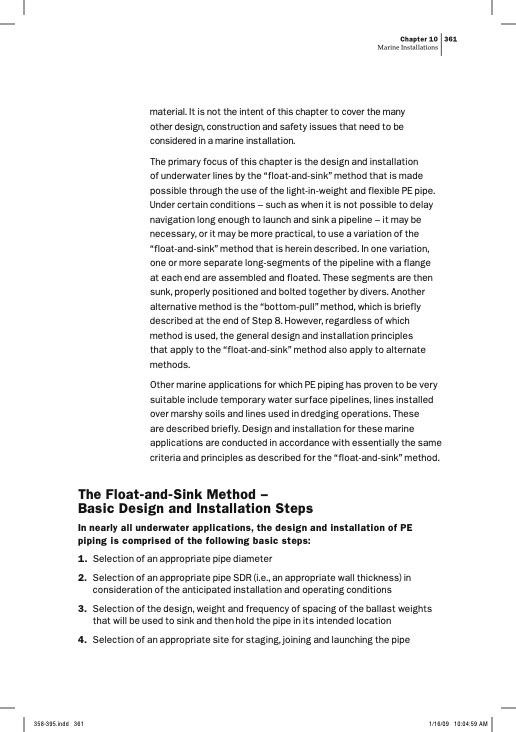
PDF Publication Title:
Text from PDF Page: 003
Chapter 10 361 Marine Installations material. It is not the intent of this chapter to cover the many other design, construction and safety issues that need to be considered in a marine installation. The primary focus of this chapter is the design and installation of underwater lines by the “float-and-sink” method that is made possible through the use of the light-in-weight and flexible PE pipe. Under certain conditions – such as when it is not possible to delay navigation long enough to launch and sink a pipeline – it may be necessary, or it may be more practical, to use a variation of the “float-and-sink” method that is herein described. In one variation, one or more separate long-segments of the pipeline with a flange at each end are assembled and floated. These segments are then sunk, properly positioned and bolted together by divers. Another alternative method is the “bottom-pull” method, which is briefly described at the end of Step 8. However, regardless of which method is used, the general design and installation principles that apply to the “float-and-sink” method also apply to alternate methods. Other marine applications for which PE piping has proven to be very suitable include temporary water surface pipelines, lines installed over marshy soils and lines used in dredging operations. These are described briefly. Design and installation for these marine applications are conducted in accordance with essentially the same criteria and principles as described for the “float-and-sink” method. The Float-and-Sink Method – Basic Design and Installation Steps In nearly all underwater applications, the design and installation of PE piping is comprised of the following basic steps: 1. Selection of an appropriate pipe diameter 2. Selection of an appropriate pipe SDR (i.e., an appropriate wall thickness) in consideration of the anticipated installation and operating conditions 3. Selection of the design, weight and frequency of spacing of the ballast weights that will be used to sink and then hold the pipe in its intended location 4. Selection of an appropriate site for staging, joining and launching the pipePDF Image | Marine Installations PE

PDF Search Title:
Marine Installations PEOriginal File Name Searched:
PE-Marine-Installations.pdfDIY PDF Search: Google It | Yahoo | Bing
Development of a solar powered Electric Ship The Electricship website originally started off as a project to develop a comprehensive renewable, affordable, modular electric ship... More Info
Modular Boat Hull Composite The case for a unsinkable, modular composite hybrid boat hull... More Info
MS Burgenstock Hybrid Electric Catamaran Lake Lucerne Unique shuttle servicing Lucerne to the Burgenstock Resort... More Info
Ground Power Unit GPU Powered by Lithium Ion Batteries The goal of the Ground Power Unit is to provide a readily accessible, modular, ready-to-power solution for remote power... More Info
| CONTACT TEL: 608-238-6001 Email: greg@electricship.com | RSS | AMP |